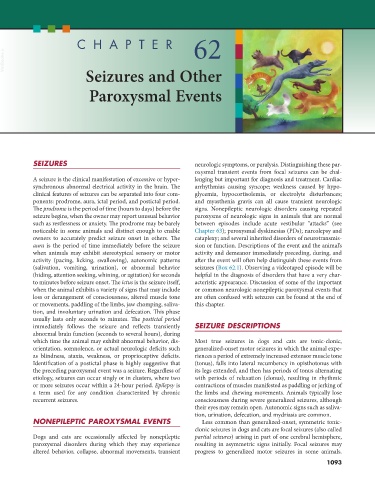Page 1121 - Small Animal Internal Medicine, 6th Edition
P. 1121
CHAPTER 62
VetBooks.ir
Seizures and Other
Paroxysmal Events
SEIZURES neurologic symptoms, or paralysis. Distinguishing these par-
oxysmal transient events from focal seizures can be chal-
A seizure is the clinical manifestation of excessive or hyper- lenging but important for diagnosis and treatment. Cardiac
synchronous abnormal electrical activity in the brain. The arrhythmias causing syncope; weakness caused by hypo-
clinical features of seizures can be separated into four com- glycemia, hypocortisolemia, or electrolyte disturbances;
ponents: prodrome, aura, ictal period, and postictal period. and myasthenia gravis can all cause transient neurologic
The prodrome is the period of time (hours to days) before the signs. Nonepileptic neurologic disorders causing repeated
seizure begins, when the owner may report unusual behavior paroxysms of neurologic signs in animals that are normal
such as restlessness or anxiety. The prodrome may be barely between episodes include acute vestibular “attacks” (see
noticeable in some animals and distinct enough to enable Chapter 63); paroxysmal dyskinesias (PDs); narcolepsy and
owners to accurately predict seizure onset in others. The cataplexy; and several inherited disorders of neurotransmis-
aura is the period of time immediately before the seizure sion or function. Descriptions of the event and the animal’s
when animals may exhibit stereotypical sensory or motor activity and demeanor immediately preceding, during, and
activity (pacing, licking, swallowing), autonomic patterns after the event will often help distinguish these events from
(salivation, vomiting, urination), or abnormal behavior seizures (Box 62.1). Observing a videotaped episode will be
(hiding, attention seeking, whining, or agitation) for seconds helpful in the diagnosis of disorders that have a very char-
to minutes before seizure onset. The ictus is the seizure itself, acteristic appearance. Discussion of some of the important
when the animal exhibits a variety of signs that may include or common neurologic nonepileptic paroxysmal events that
loss or derangement of consciousness, altered muscle tone are often confused with seizures can be found at the end of
or movements, paddling of the limbs, jaw chomping, saliva- this chapter.
tion, and involuntary urination and defecation. This phase
usually lasts only seconds to minutes. The postictal period
immediately follows the seizure and reflects transiently SEIZURE DESCRIPTIONS
abnormal brain function (seconds to several hours), during
which time the animal may exhibit abnormal behavior, dis- Most true seizures in dogs and cats are tonic-clonic,
orientation, somnolence, or actual neurologic deficits such generalized-onset motor seizures in which the animal expe-
as blindness, ataxia, weakness, or proprioceptive deficits. riences a period of extremely increased extensor muscle tone
Identification of a postictal phase is highly suggestive that (tonus), falls into lateral recumbency in opisthotonus with
the preceding paroxysmal event was a seizure. Regardless of its legs extended, and then has periods of tonus alternating
etiology, seizures can occur singly or in clusters, where two with periods of relaxation (clonus), resulting in rhythmic
or more seizures occur within a 24-hour period. Epilepsy is contractions of muscles manifested as paddling or jerking of
a term used for any condition characterized by chronic the limbs and chewing movements. Animals typically lose
recurrent seizures. consciousness during severe generalized seizures, although
their eyes may remain open. Autonomic signs such as saliva-
tion, urination, defecation, and mydriasis are common.
NONEPILEPTIC PAROXYSMAL EVENTS Less common than generalized-onset, symmetric tonic-
clonic seizures in dogs and cats are focal seizures (also called
Dogs and cats are occasionally affected by nonepileptic partial seizures) arising in part of one cerebral hemisphere,
paroxysmal disorders during which they may experience resulting in asymmetric signs initially. Focal seizures may
altered behavior, collapse, abnormal movements, transient progress to generalized motor seizures in some animals.
1093

